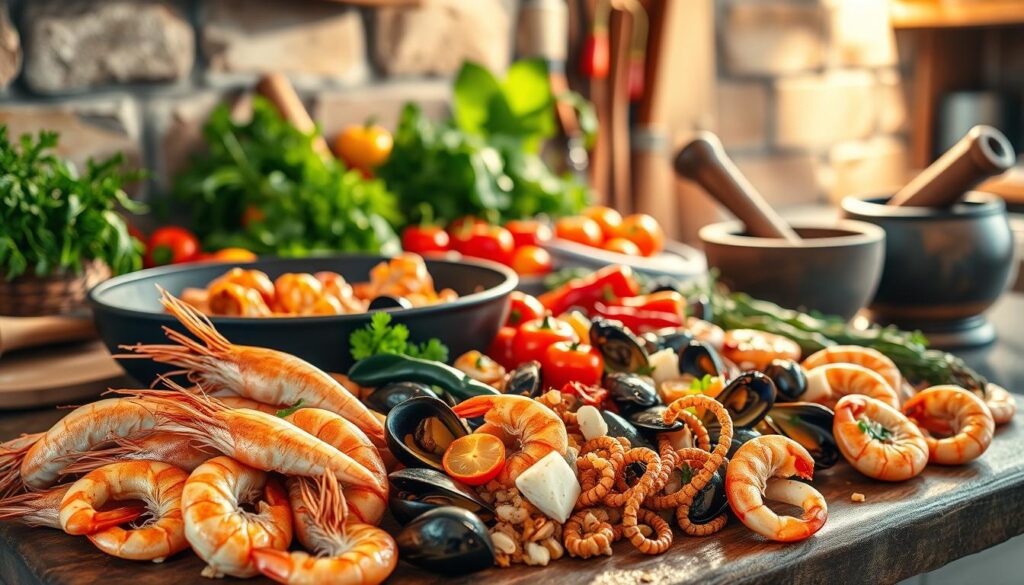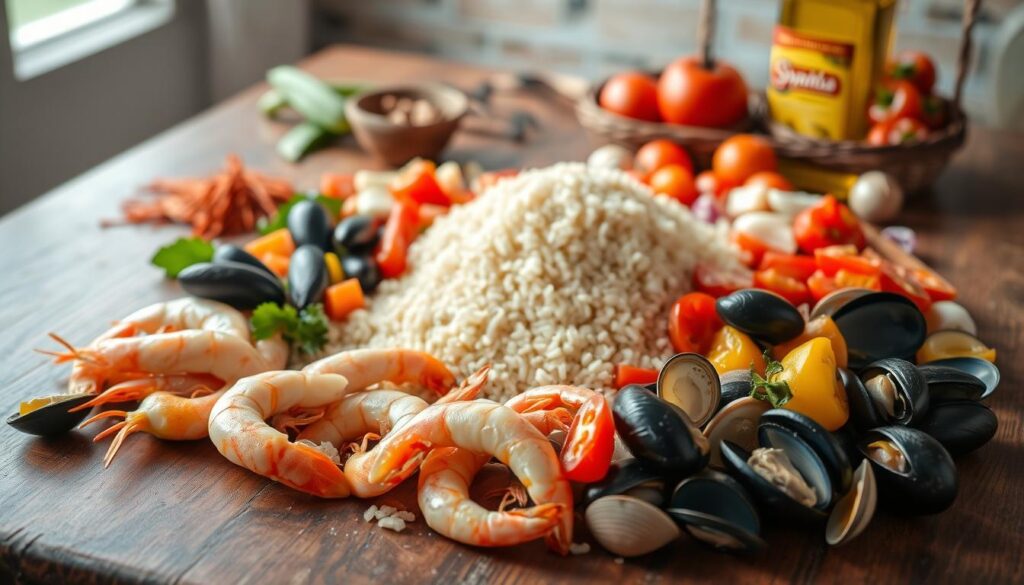Table of Contents
My first taste of authentic paella in a bustling Valencian market changed my view of comfort food. The smoky aroma of saffron, the caramelized socarrat crust, and the mix of seafood and vegetables all came together in one bite. Now, I’m excited to share this joy with you. You can make this iconic dish at home without special tools or years of training.
Key Takeaways
- Use high-quality saffron to unlock the signature golden hue and earthy flavor.
- Resist rinsing the rice to keep its natural starches for a creamy texture.
- Aim for a crispy socarrat layer by cooking uncovered on medium-low heat.
- A large skillet works perfectly if you don’t have a traditional paella pan.
- Bomba rice is ideal, but short-grain rice makes a reliable substitute.
My Personal Journey to Authentic Seafood Paella
My love for Spanish cuisine started in Valencia. I explored bustling markets and saw chefs making paella. Each ingredient had a story—saffron, seafood, and tomatoes.
This trip inspired me to make that magic at home.
Discovering the Inspiration in Spain
In Barcelona’s Mercado de Colón, I saw saffron and fresh shrimp. Chefs taught me about balance in Spanish cuisine. Saffron and sea brine were key.
I learned to keep traditions alive but also use tools like cast iron skillets.

Learning the Secrets of Traditional Recipes
Mastering technique meant keeping it simple. Here are some key tips:
– Soak Goya rice 15–20 minutes to cook faster.
– Stir the rice halfway for even flavor, as Bobby Flay suggests.
– Add shrimp and lobster early to keep them tender.
– Use cayenne for a hint of spice, like in Valencian recipes.
These tips make traditional recipes work in any kitchen. They keep Spanish cuisine alive while making it easy for us to cook at home.
Planning and Sourcing the Perfect Ingredients
Starting with the right paella ingredients is key. When I first learned to cook paella, I found out quality ingredients are a must. Here’s how to find them:
Essential Ingredients List:
- Bomba rice (Spanish specialty) or paella ingredients substitutes like Arborio or Calrose rice
- High-quality saffron threads (look for deep red color)
- Fresh seafood: shrimp, mussels, clams
- Chicken or chorizo for traditional flavor
- Chicken stock (or seafood stock for extra depth)

| Category | Key Ingredients | Substitutions |
|---|---|---|
| Rice | Bomba/Calasparra rice | Arborio, Calrose |
| Flavor Base | Saffron threads | None (critical ingredient) |
| Seafood | Shrimp, mussels, clams | Frozen alternatives (thawed) |
| Protein | Chicken, chorizo | Smoked sausage + paprika |
Always check seafood freshness: shells should snap closed when tapped. For saffron, buy small quantities in airtight containers. My go-to sources include local Hispanic markets and trusted online retailers like Amazon for hard-to-find items. Remember, even substitutions need attention to texture and flavor balance. Proper planning ensures every component works together—no shortcuts here!
Essential Tools and Equipment for Paella
Mastering paella cooking tips begins with the right tools. The right equipment is key for that perfect socarrat crust and even cooking. Here’s what you need to succeed.
Must-Have Cookware Essentials
A paella pan is essential. The Garcima Pata Negra carbon steel pan is a top pick. It has a 13.5-inch top and 11-inch base for even rice distribution.
Choose a pan with a flat bottom and sloping sides. Stainless steel is good for outdoor use, but carbon steel excels indoors. Always hand-wash and dry carbon steel pans to avoid rust.
Optional Accessories for a Better Experience
Enhance your setup with these extras:
- Boj wood spoon: Use a traditional Cullereta from Valencia for stirring without scratching pans.
- Skimmer tool: Removes excess oil when frying seafood, keeping rice dry.
- Kitchen apron: A practical nod to tradition—Valencian chefs wear them to stay clean.
- Mortar and pestle: Great for grinding spices or making mojo sauce.
Start simple: invest in a quality pan first. Add accessories as you grow confident. These tools make every step easier, whether you’re simmering broth or layering flavors. Happy cooking!
Step-by-Step Cooking Techniques
Mastering traditional paella requires precision. Here’s how I make sure every part is perfect:
Preparing a Flavorful Broth
- Simmer chicken or fish stock with saffron and smoked paprika for 20 minutes. Strain it to keep the color and smell.
- Add white wine and a bay leaf for the last 5 minutes. This adds depth to the broth.
Cooking the Rice to Perfection
| Step | Action | Timing |
|---|---|---|
| 1 | Heat pan, add olive oil, and toast bomba rice until translucent | 2 mins |
| 2 | Pour in broth gradually, maintaining a gentle simmer | 10 mins |
| 3 | Let the rice rest undisturbed for 5 minutes post-cooking | 5 mins |
Layering Flavors for Authenticity
- Sauté onions and garlic first, then add tomatoes to meld flavors before rice
- Arrange seafood (prawns, mussels) on top during the last 8 minutes of cooking
- Season with sea salt and lemon juice right before serving
Every step is like following a Valencian chef’s guide. The socarrat, or crispy rice bottom, is crucial. Don’t stir; let the heat do its job. Patience is key for that perfect caramelized crust.
When the liquid is gone and the rice is tender, your traditional paella is ready. Serve it straight from the pan. Bon appétit!
Expert Seafood Paella Techniques
Creating a seafood recipe is all about balance. Fresh seafood like shrimp, mussels, and calamari are the main attraction. But timing is crucial. Adding seafood in the last 10 minutes keeps it tender and prevents overcooking.
Mussels should be added shell-side down. This helps them steam open and release their briny juices into the rice.
- Pat dry seafood before adding to avoid diluting the broth.
- Place shrimp on the pan’s edges for even cooking; larger pieces like squid rings go in the center.
- Never stir after adding seafood—this disrupts the rice’s texture.
A 12-inch Pata Negra carbon steel pan is ideal for even heat. When the rice absorbs liquid, arrange seafood evenly. For a golden socarrat, boost heat in the last 2 minutes.
Always use Spanish Bomba rice. It keeps its shape even with seafood’s liquid. Fresh seafood adds depth to the seafood recipe. So, choose the best from reputable sources. Serve straight from the pan to enjoy every bite.
Personal Tips for Perfecting Spanish Flavors
After years of cooking and learning, I found that making how to make paella is more than just ingredients. It’s about the little details. These tips will help you make a dish that truly tastes like Spain.
Balancing Spices with Care
- Saffron is key: Use a pinch of high-quality saffron threads soaked in warm broth to unlock its floral aroma. Avoid pre-ground spice, which often lacks depth.
- Paprika choice matters: Spanish smoked paprika (pimentón) adds smokiness without overpowering. Start with 1 teaspoon and taste as you go.
- Salt strategically: Add salt only to the broth, not the rice. Over-salting ruins the balance of flavors.
Enhancing Authenticity with Every Step
Follow these steps to mirror traditional Valencian techniques:
- Sofrito foundation: Slow-cook diced onion, garlic, and tomato in olive oil until soft. This base carries the dish’s backbone.
- Layer ingredients: Add meats first, then seafood last. This ensures each protein cooks properly without overcooking delicate items like shrimp.
- Embrace the socarrat: Let the rice sit undisturbed for 5 minutes after cooking to form that prized crispy crust on the pan’s bottom.
- Serve with tradition: Pair with crusty bread and a bold red wine like Tempranillo to mirror Spanish dining customs.
Small adjustments—like toasting spices lightly or avoiding extra salt—make all the difference. These methods work every time, whether you’re using mussels from the market or chorizo for a twist. Practice these steps, and your paella will taste like it came straight from a paella pan in Valencia itself.
Understanding Regional Variations in Paella
Exploring paella recipe traditions shows a rich tapestry of flavors across Spain. My journey showed how different places and cultures turn this dish into a story of local tastes.
| Region | Type | Signature Ingredients | Key Notes |
|---|---|---|---|
| Valencia | Paella Valenciana | Rabbit, chicken, green beans, saffron | Original recipe emphasizing saffron-infused rice |
| Catalonia | Paella de Marisco | Shrimp, mussels, paprika, squid ink | Coastal focus with bold seafood combinations |
| Basque Country | Basque-style | Cod, red peppers, chorizo | Blends mountain and sea flavors |
| Andalusia | Paella mixta | Pork, artichokes, tomatoes | Hybrid of land and sea ingredients |
Today, paella recipe innovations keep this tradition alive. Try:
- Vegetarian versions using roasted veggies and mushrooms
- Fusion twists like coconut-infused rice or chorizo-tomato blends
- Regional spices like smoked paprika or safflower threads
My kitchen experiments showed that you can make authentic paella at home. Whether you like seafood or meat, each version tells a new story.
Troubleshooting Common Paella Challenges
Mastering paella means learning from mistakes. Here’s how to fix common issues I’ve faced:
- Overcooked rice? Use Spanish bomba or Calasparra rice—they hold their shape. Cook uncovered on medium heat for 18 minutes. No peeking!
- Mushy texture? Avoid overcrowding your pan. A wide, shallow paella pan ensures even evaporation. Never stir rice after adding liquid.
- Flat flavor? Homemade seafood stock beats store-bought. Simmer shrimp shells and fish bones for 30 minutes for depth.
I’ve seen many paella fails from shortcuts. Here’s what to cut:
- No onions or mushrooms—they dilute the seafood focus. Stick to clams, mussels, and shrimp.
- Never substitute saffron. Use threads from La Mancha or Tenerife for authentic golden color and aroma.
- Let it rest 5 minutes after cooking. This step develops socarrat (crispy bottom) and dries excess moisture.
Remember: Less is more. Overloading with ingredients turns paella into a soggy mess. Trust traditional methods—they’ve survived centuries for a reason.
Creative Twists on the Traditional Recipe
Paella doesn’t have to be the same every time. Let your local market and seasons guide your choices. This way, you keep the dish’s soul intact. Here’s how I’ve taken classic paella beyond its origins:
Incorporating Locally Sourced Seafood
Swap imported mussels for fresh catches from your region. In California, Dungeness crab legs add a briny kick. Using quinoa instead of rice works well in gluten-free diets, paired with Andalusian saffron for authenticity. Always taste as you go to balance flavors.
Seasonal Adjustments for Extra Flavor
Roasted butternut squash in fall or zucchini in summer brings color and texture. A handful of sun-dried tomatoes in winter adds tang. Toss in fresh herbs like parsley or cilantro right before serving—they wake up the dish instantly.
Exploring Fusion Ideas
Blend cultures by mixing paella with global flavors:
- Thai-inspired: Stir in coconut milk and a hint of lemongrass
- Mediterranean twist: Add kalamata olives and artichoke hearts
- Southwestern flair: Top with diced avocado and a dash of chipotle
Experimenting keeps the dish fresh—like using smoked paprika or turmeric for depth. Just keep the paella pan’s wide surface to ensure even cooking. Your taste buds will thank you!
Conclusion
Starting to make Spanish cuisine at home is easy. You just need to know the basics. I learned that Bomba rice and a mix of shrimp, mussels, and squid are key. These ingredients are the heart of this famous dish.
Whether you stick to a traditional recipe or try new things, the secret is to respect the old ways. But also, don’t be afraid to add your own twist. This way, you can make the dish your own.
Paella changes with each region, but it always stays true to its roots. You can make it with seafood or even use plants instead. The most important thing is to enjoy the process and learn as you go.
Paella is more than just food; it’s about sharing moments with others. It brings people together, whether it’s for a family dinner or a casual get-together. Feel free to add your own touches, like local seafood or fresh veggies.
Now it’s your turn to try making paella. Get a paella pan and find the best ingredients. Follow the traditional ways or add your own flair. Share your creations online with #SeafoodPaellaStories. Let’s keep the conversation going.
FAQ
What kind of rice is best for making paella?
Bomba rice is the top choice for paella. It’s a short-grain rice that soaks up liquids well but stays firm. If bomba is hard to find, look for other short-grain rice high in starch.
Can I use frozen seafood for my paella?
Yes, frozen seafood works great! Just thaw it before adding it to your paella. While fresh seafood is amazing, frozen can still make a tasty dish.
What is socarrat and how do I achieve it?
Socarrat is the crispy rice layer at the bottom. To get it, cook the paella without stirring the last bit. Turn up the heat a bit to caramelize the bottom. But watch it to avoid burning.
Can I make paella without a paella pan?
Definitely! You can use a large skillet or shallow pan instead of a paella pan. Just watch the cooking time and adjust as needed.
How do I prevent my paella rice from becoming mushy?
To avoid mushy rice, don’t stir it once it starts cooking. Use the right amount of liquid and watch the cooking time. If there’s too much liquid, uncover the pan to let steam out.
What spices are essential for an authentic seafood paella?
Saffron is key for traditional paella, giving it color and flavor. Paprika also adds depth. Use high-quality spices for the best aroma and taste.
Are there vegetarian options for paella?
Yes, vegetarian paella is a great choice! Use seasonal veggies, beans, and plant-based proteins instead of seafood and meat. It keeps the dish flavorful.
SEE MORE : Delicious Peanut Butter Cookies - Bake With Ease
